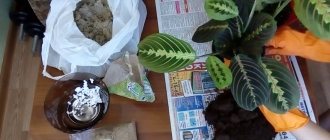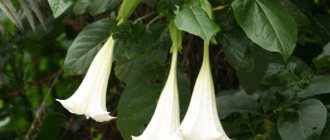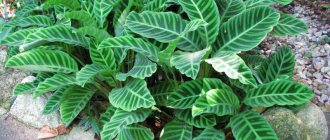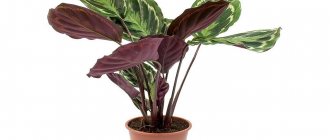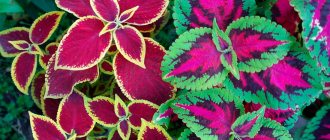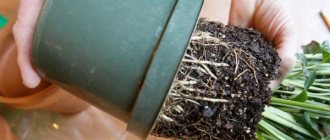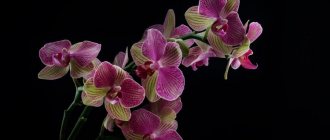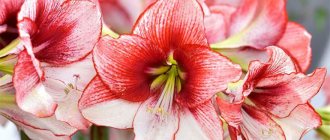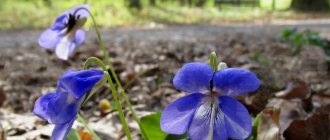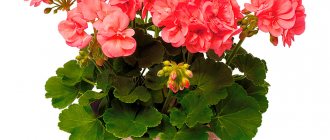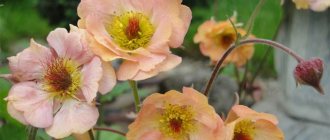This amazing plant comes from the tropical forests of South America. Belongs to the large Marantov family. Calathea, the species whose photos are presented below, has a wide variety in nature.
Today there are more than 200 varieties of this flower. Its highlight is leaves with unique patterns. They resemble intricate watercolors with broad strokes, spots and stripes.
The leaves themselves vary in shape, size and texture. They have smooth or wavy edges , shine with a glossy shine or surprise with a delicate velvety.
Interesting! In its natural environment, calathea reaches several meters in height and has fairly dense stems.
Residents of tropical jungles cover roofs with them, weave baskets and even use them for healing. Another distinctive feature of calathea is the movement of leaves. This only happens at night. The leaves with a characteristic rustling sound are folded together , like palms during prayer.
This video shows the movement of calathea and arrowroot leaves.
Calathea Makoya
The most popular type in indoor floriculture. The leaves are tender and thin, like paper, wide with blunt ends, have a bluish tint , but along the edges there is a green border.
The leaf blade is dotted with veins and covered with dark oval-shaped spots. Another name is “peacock flower”. An interesting combination of an almost transparent base with a clearly defined pattern is created.
Pest and disease control
Pests and parasites are very dangerous for sensitive and delicate calathea. Aphids, scale insects, and thrips especially love juicy young leaves, and it is quite difficult to notice them in the initial stages. First, wash the flower with herbal infusions or soapy water, and then treat it with special chemical insecticides.
If the lower leaves turn yellow and fall off, this may be a natural seasonal process. But if the same thing happens to the top ones, most likely the flower does not have enough moisture and watering. Dry tips are a sure signal of the need to humidify the air and spray the foliage.
If the flower withers and dries, and the leaves wrinkle and curl, it may be too cold. Dry faded spots are sunburn and are especially easy to get on top of wet sprayed plates.
Photo: greenway-schop.ru
Kalathea Varshevich
It is distinguished by oval velvety leaves. The main color of the plate is rich green, but closer to the central vein the tone is much lighter. The reverse side is pinkish-purple .
The bush itself is quite compact; this species blooms with spikelet-shaped inflorescences , the bracts are bent, similar to rose petals. Peduncle geniculate. At its nodes, rosettes are formed that are used for reproduction.
Note! Calathea Painted has very beautiful leaves. In the center of the dark green plate, as if a smaller leaf of a light shade is depicted.
Calathea saffron
Its leaves are oval and have wavy edges. The outer side is painted dark green, and the reverse side is brown. This plant is also famous for its spectacular and regular flowering.
The species got its name from the color of the inflorescences - they are saffron . Aquariums and wet greenhouses are suitable for growing this beauty. In dry air conditions, leaves actively fall off.
What does the Calathea prayer flower bring to the house: signs and superstitions
The popular names of calathea play on the theme of prayer: prayer flower, prayer flower, prayer flower, praying flower. Calathea curls its leaves in the evenings, and in the morning, when the sun rises, it straightens them again - hence its unusual name.
By the way, in fact, a prayer book is not a person who prays, but a book in which prayers are written.
Another name for calathea is also associated with religion: many varieties have exactly ten spots on the leaves, so the indoor flower began to be called the “ten commandments.”
Of course, a plant with such a halo in the mass consciousness must have various magical properties. Here they are:
- In general, Calathea has a very positive aura. It is believed that it helps people set goals, helps in reflection, in search of the meaning of life or simply the next step in a particular area. Moreover, achieving such goals becomes easy, as if the flower attracts good luck and helps resolve conflicts.
- It is believed that calathea helps you find yourself, a hobby in which your inclinations and skills will best reveal themselves.
- Also, reviews about the magical properties of the plant say that it helps restore health in older people.
By the way, this also has a more or less scientific basis: calathea has large, bright green leaves that purify the air, and when a person breathes fresh, clean air, his cardiovascular system improves, and therefore his overall well-being, because much in the human body depends on the work of the heart and lungs.
- Strengthens self-confidence and helps make family relationships more harmonious. This also applies to marital relationships.
- Calms children, helps them fall asleep more soundly and quickly, and helps them develop more easily and more actively.
- According to the Feng Shui system, calathea is a flower filled with solar energy Yang and under the auspices of Mars. Therefore, it also helps with health: it strengthens the cardiovascular system, drives away colds and even attracts wealth.
- They say that the prayer flower tree blooms when there is a seriously ill person in the house. Flowering, as it were, takes away the heavy, negative energy of the disease and helps the person recover. This distinguishes it from other plants: they dry out more often if they anticipate someone’s serious illness, as if foreshadowing trouble.
Whether to believe in all this is up to you to decide, but one way or another, calathea is a beautiful flower that is quite easy to care for and maintain; growing it at home does not cause much trouble, and it brings a lot of joy with its bright green appearance alone. Plus it really cleanses the air and calms the nerves by contemplating the beauty and calming green color.
Calathea Decorated
It is distinguished by the elongated oval shape of the leaves (pointed edges) and a distinct central vein. On the surface of the leaves there are thin white or pinkish stripes , reminiscent of shading.
As the plant matures, they gradually become paler. Calathea Decorated combines many cultivated varieties.
Calathea striped
The length of the leaf reaches 30 – 40 cm. The surface is velvet. The light base has wide, symmetrical dark stripes (similar to bird feathers). Often in the literature this type of calathea is called zebrina .
The inflorescences are small in size, the pedicels are shortened. The reverse side of the leaf surface is reddish.
Note! Calathea Mix is very similar to the striped one, a novice gardener can easily get confused. The thing is that its leaf plates have a dark background with light stripes, while the striped one has the opposite.
Reproduction methods
Dividing the bush
When transplanting calathea, which is carried out in the spring, the rhizome of an adult bush can be divided into parts if desired. It should be taken into account that each of the divisions must have several formed roots and leaf plates. Plant the cuttings in individual pots, reaching 70–90 mm in diameter, which are filled with arrowroot substrate. Place them in a shaded area and provide them with warmth and high humidity. To do this, it is recommended to place the pots on a tray filled with wet expanded clay, and a working heating device should be located not far away. Rooting cuttings takes a very long time, and the final result depends on how well you take care of them.
Propagation by cuttings
Very carefully cut off the above-ground cuttings from the mother bush. For rooting, it is planted in a moistened substrate, after which it is covered with a cut-off plastic bottle or a transparent bag. It will be possible to remove the cover only when the cuttings take root. When starting cuttings, you need to take into account that the cutting may not give roots, and this happens quite often.
Growing from seeds
It is extremely difficult to grow calathea from seeds, since even high-quality seed material may not sprout. Take a bowl and fill it with a substrate consisting of sand and leaf soil (1:2), after which the seeds are sown in it. Crops are harvested in a warm place (from 21 to 25 degrees). After the first pair of true leaf blades have formed on the emerging seedlings, they will need to be planted into a box filled with the same substrate that is used for sowing. Grown and strengthened plants are transplanted into separate pots.
Calathea - home conditions. [Hope and Peace]
Calathea Rufibarba
Dense leaves on long petioles, narrowed, have wavy edges. The petioles and leaves are beautifully pubescent.
The monochromatic color slightly detracts from the decorative value of the species, but this “red-bearded flower” compensates for this disadvantage by the presence of a light fluff on the back of the leaf. On the basis of Rufibarba, the spectacular varieties “Blue Grass” and “Wavestar” were created.
Calathea Roseopicta
The leaves of this species are attractive on both sides. Their upper part is dark emerald with sweeping stripes shimmering in silver, light green or soft pink , the lower part is blackberry color with a white border.
Calathea Roseopicta has always been the focus of attention of breeders. Varieties were bred with stripes of different widths, which gave the flower a special charm.
Calathea Loseneri
The leaves are lancet-shaped and close in color to chartreuse. They do not have variegated patterns. Small star-shaped flowers give the plants a special charm. Nevertheless, calatheas of this species have found their place in the hearts of flower lovers.
What do you think Calathea brings to the house? This flower is a symbol of happiness . It is believed that where it grows there will be peace and tranquility.
Growing conditions
Calathea - as befits a real beauty, it requires care. She needs to provide specific growing conditions that are as close to natural as possible - warmth, high air humidity, and a constantly moist substrate.
Optimal position
Calathea naturally grows in tropical forests where there is little light. When grown at home, it should be in a semi-shaded place. Placement depends on the time of year and the amount of solar insolation:
- In the off-season, a room with windows of northern or northwestern exposure, where there is diffused sunlight, is better suited.
- In summer, the plant should not be placed near a south or west window; it is better to choose an eastern exposure, preferably behind a curtain.
- In winter, placement on an east window may cause a lack of light, then it is good to move the flower to the south side.
It is better not to expose the plant to direct sunlight. Just a few minutes of exposure to the burning summer sun will cause a protective reaction in the form of leaf curling, followed by irreversible burns. In full sun, decorative leaves lose their intense color and the tips may get burned. Only in the autumn-winter period it is necessary to provide the calathea with a little more light, because the days are short and often cloudy.
Attention! Calathea should not stand in a draft; it does not tolerate gas combustion products from kitchen gas stoves and exposure to cigarette smoke.
The plant should be especially protected from sudden changes and increases in temperature, and if possible, transferred to another room when opening windows and ventilating.
Calathea is a heat-loving plant; it grows and develops best at a temperature of 27-29 degrees. After the growing season, the temperature is lowered.
The temperature should vary throughout the year:
- in summer you need to ensure a minimum of 20-25 degrees;
- in winter the temperature should not fall below 16-18 degrees,
Attention! At temperatures below +10 degrees the plant begins to die.
Suitable substrate
When composing the soil mixture, special care should be taken to ensure a high content of ingredients that ensure water permeability and air access to the roots. The optimal substrate for growing calathea will be a mixture of compost soil or peat with coarse sand and fermented bark with the addition of (20-40%) perlite or expanded clay.
It is important that the substrate is:
- permeable;
- with an acidic reaction (5-6 pH).
A drainage layer (gravel, pebbles, expanded clay) must be poured onto the bottom of the pot. Although the plant likes moist soil, it is susceptible to root rot if it is flooded.
Calathea Remarkable
Calathea Remarkable has another name - lanceolate. The leaves are xiphoid in shape, large (up to 45 cm), have a wavy edge, and are planted on short petioles . The pattern is a mirror reflection of dark oval spots.
Against the background of this beautiful design, on the back of the sheet look especially bright Calathea lanceolate is one of the most popular among gardeners.
Calathea Leopardova
Plants of this species do not have stems. The leaves are narrow and relatively short (only 15 cm), with elliptical-shaped spots radiating from their central part in different directions . The light base is combined with deeper stain tones.
The pattern on the leaves is somewhat similar to the coloring of leopard fur. How does Leopard Calathea bloom ? The buds delight with rich yellow shades.
general characteristics
Calathea is a colorful inhabitant of tropical forests, but its distribution area is not limited to South America. Different varieties of the arrowroot family cover all tropical regions: from Oceania to Africa.
As a rule, calathea is a vine or herbaceous plant; other forms are rare. It is notable for its powerful and developed rhizome, which actively absorbs moisture and nutrients. Of all the tropical flowers that have migrated to our latitudes, calathea is one of the most moisture-loving.
Photo: gardennews.ru
With enough light, heat and water, perennial calathea grows over the years. Even in a room it can grow more than a meter with a voluminous and lush foliage head. Large plates of different shades stretch up to 20 cm in length.
Calathea leaves can be plain, variegated or painted in different shades on both sides. Their elastic and strong central core was previously used by basket weavers and even to strengthen the roof. Actually, the name of the flower is translated as “basket”.
The flowering of calathea is unremarkable and inconspicuous, so gardeners value it as a deciduous plant. Thanks to a special natural mechanism, during the day the plates unfold behind the sun, and by night they roll up and lower.
Photo: flora-world.ru
Calathea Litze
Calathea Litze lives exclusively in humid tropical environments. Under optimal conditions, plants grow quite densely, turning into real wilds .
The leaves are covered with distinct patterns that resemble dried watercolors. The upper side shines with silver threads, and the lower side is a mixture of purple and red. The inflorescences are small , spike-like, pure white.
Conclusion
An amazingly beautiful flower, as if endowed with magical qualities, is Calathea, a well-known flower among domestic gardeners. True, despite its exotic, inimitable beauty, which can elevate absolutely any flower garden to a new level, the plant has become famous as incredibly sensitive to care. Even not all experienced flower growers really cope with it.
Of course, we recommend not to overestimate your strengths, but to carefully prepare for choosing a variety, and then caring for Calathea. And you have already taken the first step towards this by reading our article.
For our part, we wish you good luck, because a well-groomed and fragrant Calathea in your greenhouse will certainly become a kind of order, evidence of your professional success in floriculture!
Calathea Burle Marx or "Blue Ice"
Named after landscape designer Burle Marx. He created not only unique projects for gardens and parks, but was also an ardent admirer of beautiful flowers .
The color of the leaves is dominated by pastel tones of green with silver tints , but the flower petals amaze with a delicate bluish tint, reminiscent of frozen ice.
Watering
The frequency of watering is related to air humidity. If it is high - 80%, then watering once every 3 days is enough. If the humidity is lower, then watering should be more frequent. Focus on the top layer of soil - if it has dried out by 2-3 cm, then you can water it.
Water quality is also very important. It is better to use soft water without chlorine, standing for 2-3 days or boiled, or even better rain or melt water, at room temperature.
Avoid stagnation of moisture in the pan and drain excess water from it after 20 minutes. after watering.
If you are going on vacation
It is not recommended to leave Calathea unattended for more than a week. Don't water it for future use - this can lead to rotting of the root system, and without watering it will die.
Calathea Mosaic network
Calathea network stands out for its strict geometry. Distinct veins of rich lettuce divide the leaf into many small squares, forming the appearance of a mosaic. The leaves have a dense structure , shaped like a heart or the tip of a spear. This plant takes root well in apartments and needs slightly less air humidity.
Note! There have always been signs and superstitions around calathea. It is believed that if you place a pot of this plant on the eastern side of the house, it will attract wealth and health.
Description of the plant
Calathea is an evergreen perennial plant belonging to the Marantaceae family. About 300 species of the genus Calathea are known, occurring naturally in South and Central America and the Caribbean. In our climatic conditions, calatheas are grown as ornamental indoor plants.
The name of the genus Calathea is due to the fact that baskets were previously woven from the leaves. In ancient Greek, the word Kalathos means "basket".
This is interesting. In English, the plant is called prayer plant or “prayer plant” because of its special adaptation to the rhythm of day and night. At dusk, the leaves fold vertically, like hands in prayer.
The main decoration of calathea is large leaves on the underside that are purple, and on top - green, white, pink, purple or brownish. Their additional decoration is stripes and patterns, giving each plant an original character. They look as if each leaf was individually painted with original patterns.
These perennials inhabit the low, dark layer of the tropical forest. To “catch” as much light as possible, the plant directs its leaves towards the sun. The petioles have articular cushions, thanks to which they move in response to light.
During the day they change position:
- at midday, when there is a lot of light, the leaf blades are parallel to the ground to consistently follow the light;
- in the evening - perpendicular to the light;
- at night - they take a vertical position, look like hands folded in prayer;
- at dawn they begin to unfold again.
Sometimes during the day the leaves may curl if the sun is too hot. They have the ability to fold along the main vein, which protects them from sunburn and excessive moisture loss. Regardless of the amount of light, the plant's biological clock also controls nighttime movement.
If a plant has a lot of leaves, they rub against each other when moving behind the sun, making a characteristic rustling sound.
Advice. If you want to capture the movement of leaves on film, find the time-lapse mode in your camera settings. Place the camera still and turn it on. The recording should take about an hour, but the video itself in this version will take up to 30 seconds. In accelerated viewing you can see what the phenomenon of the plant lifting its leaves looks like. Just like in National Geographic nature films.
Two other species of the family Marantha, related to “praying” plants, are also cultivated as indoors: arrowroot (Marantha) and stromantha (Stromanthe). Their foliage has a shape and pattern similar to that of the Calathea, but older specimens produce longer shoots and inflorescences with a different structure. There is no need to confuse them.
The plant can grow up to 0.5 m wide and 0.5 m high (the largest specimens reach a height of 1 meter). During the growing season, calathea can produce 5-6 new leaves.
Calathea flowers have different colors and shapes depending on the type and variety.
According to scientific research from NASA, some plants are more effective than other types in improving indoor air quality. Calathea has the ability to cleanse the air of toxins and harmful substances. This indoor plant will ensure that harmful gases are neutralized by absorbing and decomposing them. Plants improve indoor air humidity and occupant health by efficiently converting carbon dioxide (CO2) into oxygen.
Pink-colored roseopicta or medallion
It is distinguished by unusual leaves: on the reverse side they are reddish, and the upper part of the plate has circular patterns consisting of various shades of green .
Calathea is a plant that is valued not only for its unique leaves and flowers, but also has a beneficial effect on people on a mental level. This beauty is capable of absorbing the energy of aggression , bringing peace not only to the family, but also to the work team.
It symbolizes family happiness and home comfort. In addition to indoor floriculture, calathea varieties are used in floristry , since their stems remain fresh in water for a long time.
Transfer
When the roots appear in the drainage hole, Makoya needs to be transplanted into a larger pot. In the future, do this once every 2 years. Better in early spring. When transplanting you need:
- Water the flower generously.
- Carefully remove from the container, being careful not to damage the earthen lump.
- Carefully free the roots from the substrate.
- Cut off the rotten roots with a sharp knife and sprinkle with crushed charcoal or activated carbon.
- Place the roots in a new pot.
- Cover with fresh soil, making sure that the calathea stands strictly horizontally.
- Lightly press the soil without compacting it.
Then water the plant and place it in a cool place for 2 days. We will carry out the next watering in ten days. Choose a ceramic pot, wide and shallow.
